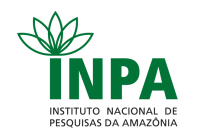Corpo Discente - Egressos
Angela Marcia Selhorst e Silva Beserra
| Título | AVALIAÇÃO DA ATIVIDADE E MECANISMO DE AÇÃO GASTROPROTETOR DO EXTRATO HIDROETANÓLICO DAS FOLHAS DE Terminalia argentea Mart. | ||||||||||||||||||||||||
| Data da Defesa | 03/10/2018 | ||||||||||||||||||||||||
| Download | Em sigilo | ||||||||||||||||||||||||
Banca
| |||||||||||||||||||||||||
| Palavras-Chaves | Terminalia argentea, úlcera gástrica, toxicidade, compostos fenólicos | ||||||||||||||||||||||||
| Resumo | Conhecida popularmente como capitão, Terminalia argentea (Combretaceae) é uma planta nativa do Brasil, cuja infusão das folhas é utilizada para úlceras. Este trabalho foi realizado com o objetivo de investigar a toxicidade e avaliar a atividade e o mecanismo antiúlcera do extrato hidroetanólico das folhas de T. argentea (EHTa) em modelos in vivo e in vitro, bem como avançar nas análises fitoquímicas. A fitoquímica preliminar e CCD do EHTa revelaram a presença de compostos fenólicos, flavonoides, saponinas, taninos e fitoesterois. Os dados da CLAE revelaram a presença de ácido gálico, rutina, ácido elágico, catequina, quercetina e kaempferol. Na análise por espectrometria de massas, a presença de ácido gálico, rutina, ácido elágico e quercetina foram confirmados e outros identificados. Os teores de fenóis, flavonoides totais e fitosterois, obtidos por espectrofotometria, representaram 18,8, 10,8 e 18,9 % da composição do extrato liofilizado, respectivamente. No ensaio com azul de Alamar, o EHTa não exibiu efeito citotóxico em células CHO-K1 e AGS. A genotoxicidade in vitro do EHTa (10, 30 ou 100 μg/mL) foi avaliada pelos testes do micronúcleo e cometa utilizando células CHO-K1. No ensaio do micronúcleo o EHTa aumentou o número de micronúcleo e de broto nuclear em células binucleadas nas três concentrações testadas e o número de ponte nucleoplasmática com 30 μg/mL. No teste do cometa, o EHTa (10 e 100 μg/mL) foi genotóxico em células CHO-K1 não expostas ao H2O2. Em pré-tratamento, o EHTa em todas as concentrações testadas preveniu o dano ao DNA induzido pela exposição ao H2O2. No cotratamento com H2O2, o EHTa foi genotóxico nas três concentrações. E no pós-tratamento, o dano ao DNA, em células CHO-K1 expostas ao H2O2, foi revertido em 22,5% com EHTa 10 μg/mL. No ensaio de toxicidade aguda o EHTa administrado v.o em dose única de até 2000 mg/kg não provocou morte nos camundongos, e os sinais clínicos que surgiram foram piloereção e diarreia reversíveis. Nenhuma alteração macroscópica foi observada nos órgãos analisados. O teste de toxicidade subcrônica foi realizado pela administração oral de EHTa (50, 200 e 800 mg/kg) em ratas por 30 dias. O consumo de ração no grupo tratado com 800 mg/kg, foi menor pontualmente no 18º dia. A administração subcrônica do EHTa também reduziu em 13 % o colesterol total nos animais tratados com 800 mg/kg e, na dose de 50 vii mg/kg provocou basofilia. Nenhuma outra alteração foi observada nos demais parâmetros bioquímicos e hematológicos nas três doses testadas. Não houve mudanças macroscópicas e histopatológicas nos órgãos dos animais tratados com EHTa, porém o peso relativo do coração dos animais tratados com 800 mg/kg foi 13,2% menor que no grupo veículo. A atividade gastroprotetora e o efeito antisecretório do EHTa (12,5, 50 e 200 mg/kg) foi avaliada em camundongos ulcerados por etanol/HCl e ligadura do piloro, respectivamente. O EHTa (12,5 e 50 mg/kg) reduziu em 55,8 e 40,6%, e a carbenoxolona (100 mg/kg v.o) em 47,9% as lesões gástricas por etanol/HCl. Em camundongos com ligadura do piloro, o EHTa reduziu o volume gástrico em 78,4, 36,1 e 43,7% nas doses de 12,5, 50 e 200 mg/kg, respectivamente, e o omeprazol em 30,9%. EHTa também reduziu a acidez total em 85,8% (50 mg/kg) e 45,8% (200 mg/kg), enquanto o omeprazol reduziu em 58,3%. Na análise do pH, a administração do EHTa aumentou o pH nas doses de 50 (68,4%) e 200 mg/kg (56,3%), e omeprazol, em 86,3%. Nos ensaios de DPPH, FRAP e NO, o EHTa apresentou efeito antioxidante in vitro com uma CI50<6,25; 53,69±3,24 e 147,1±1,48 μg/mL, respectivamente. No ensaio anti-H. pylori in vitro, o EHTa não apresentou CIM nas concentrações testadas, porém reduziu em 22% a turbidez das placas com H. pylori. Os resultados revelaram que o EHTa não é citotóxico in vitro para células CHO-K1 e AGS, porém, nos ensaios de genotoxicidade in vitro pode induzir diferentes respostas conforme concentração e condição experimental, podendo ora ser genotóxico, ora prevenir ou reverter a genotoxicidade induzida. Nos modelos de toxicidade in vivo, o EHTa mostrou-se relativamente seguro após administração aguda em camundongos; e subcrônica em ratas (NOAEL de 800 mg/kg/dia); e que, portanto, o EHTa tem uma boa margem de segurança para uso terapêutico. Os resultados de atividade antiulcerogênica e antisecretória do EHTa possivelmente estão relacionados à presença de compostos fenólicos antioxidantes, e validam de certo modo seu uso popular. | ||||||||||||||||||||||||
| Abstract | Popularly known as capitão, Terminalia argentea (Combretaceae) is a plant native to Brazil, whose infusion of leaves is used for ulcers. This work was carried out to investigate the toxicity and to evaluate the antiulcer activity and mechanism of the hydroethanolic extract of the leaves of T. argentea (HETa) in in vivo and in vitro models, as well as to advance in the phytochemical analyzes. The preliminary phytochemistry and TLC of HETa revealed the presence of phenolic compounds, flavonoids, saponins, tannins and phytosterols. The CLAE data revealed the presence of gallic acid, rutin, ellagic acid, catechin, quercetin and kaempferol. In the mass spectrometry analysis, the presence of gallic acid, rutin, ellagic acid and quercetin were confirmed and others also identified. Phenols, total flavonoids and phytosterols obtained by spectrophotometry represented 18.8, 10.8 and 18.9% of lyophilized extract composition, respectively. In the Alamar blue assay, HETa showed no cytotoxic effect on CHO-K1 and AGS cell lines. In vitro genotoxicity of HETa (10, 30 or 100 μg/mL) was assessed by micronucleus and comet assays using CHO-K1 cells. In the micronucleus assay HETa increased the micronucleus and nuclear bud number in binucleate cells at the three concentrations tested and the nucleoplasmic bridge number at 30 μg/mL. In the comet test, HETa (10 and 100 μg/mL) was genotoxic in CHO-K1 cells not exposed to H2O2. In the pretreatment, HETa at all concentrations tested prevented DNA damage induced by H2O2 exposure. In co-treatment with H2O2, HETa was genotoxic at all three concentrations. And in the post-treatment, DNA damage in CHO-K1 cells exposed to H2O2 was reversed in 22.5% with 10 μg/mL HETa. In the acute toxicity test HETa given in a single dose of up to 2000 mg/kg did not cause death in the mice, and the clinical signs that emerged were reversible piloerection and diarrhea. No macroscopic changes were observed in the analyzed organs. The subchronic toxicity test was performed by oral administration of HETa (50, 200 and 800 mg/kg) in rats for 30 days. Feed intake in the group treated with 800 mg/kg was lower on the 18th day. Subchronic administration of HETa also reduced total cholesterol by 13% in animals treated with 800 mg/kg and basophilia was observed at the dose of 50 mg/kg. No other alteration was observed in the other biochemical and hematological parameters in the three doses tested. There were no macroscopic and histopathological changes in the organs of ix animals treated with HETa, but the relative heart weight of animals treated with 800 mg/kg was 13.2% lower than in the vehicle group. The gastroprotective activity and the antisecretory effect of HETa (12.5, 50 and 200 mg/kg) were evaluated in mice ulcerated by ethanol/HCl and pylorus ligation, respectively. HETa (12.5 and 50 mg/kg) decreased by 55.8 and 40.6%, and carbenoxolone (100 mg/kg v.o) by 47.9% the gastric lesions induced by ethanol/HCl. In mice with pylorus ligation, HETa reduced gastric volume by 78.4, 36.1 and 43.7% at the doses 12.5, 50 and 200 mg/kg, respectively, and omeprazole by 30.9%. HETa also reduced total acidity by 85.8% (50 mg / kg) and 45.8% (200 mg / kg), while omeprazole reduced by 58.3%. In the pH analysis, the administration of HETa increased pH at the doses of 50 (68.4%) and 200 mg/kg (56.3%), and omeprazole by 86.3%. In the DPPH, FRAP and NO assays, the HETa showed antioxidant effect in vitro with an IC50 <6.25; 53.69 ± 3.24 and 147.1 ± 1.48 μg/mL, respectively. In the anti-H. pylori in vitro, HETa did not show MIC at the concentrations tested, but it reduced the turbidity of H. pylori plaques by 22%. The results showed that HETa is not cytotoxic in vitro to CHO-K1 and AGS cells, but in in vitro genotoxicity assays, it resulted in the induction of varying responses depending on the concentration and experimental condition, may be some genotoxic, or sometimes prevent or reverse the induced genotoxicity. In the in vivo toxicity models, HETa was shown to be relatively safe after acute administration in mice; and subchronic in rats (NOAEL of 800 mg/kg/day); and therefore, HETa has a good safety margin for therapeutic use. The results of antiulcerogenic and antisecretory activity of HETa are possibly related to the presence of antioxidant phenolic compounds, and seem to support, in a certain way, its popular use. | ||||||||||||||||||||||||
Parceiros

























